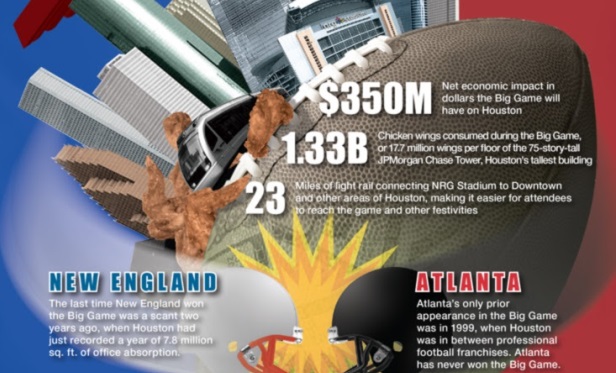 The economic impact on Houston will be a boost to area businesses (credit: NAI Partners).
The economic impact on Houston will be a boost to area businesses (credit: NAI Partners).
HOUSTON—Houston last hosted a Super Bowl in 2004. When comparing commercial real estate and other stats for 2004 and 2017, some interesting items emerge. Among other things, the phenomenon of shrinking office space (average square footage per US worker, then and now). According to Cushman & Wakefield, in 2004, there was 250 square feet per worker and in 2017, 151 square feet per worker.
NAI Partners points to office net absorption in 2004 at 725,660 and today, it stands at -64,358, GlobeSt.com learns. In 2004, 18.2 million square feet of space was leased and current space leased is 2.39 million square feet. The average asking rent per square foot in 2004 was $17.93 and today, it is $21.54. Ironically, the office vacancy rate today is the same as in 2004: 15.7%.
For industrial properties, NAI says net absorption in 2004 was 2.23 million square feet and today it is 8.6 million square feet. Leasing activity hit 15.57 million square feet in 2004 and today, industrial leasing activity is at 21.68 million square feet. The average asking industrial rent per square foot in 2004 was $5.68 and today, it is $7.21. The industrial vacancy rate was 8.9% in 2004 and today, it is 5.6%, GlobeSt.com learns.
And between 1974 (the first time Houston hosted) and 2017, there have been large increases, as one might expect, in office inventory, gross metro product, US population rank and average ticket prices. Office inventory in 1974 was 32 million square feet and today, it is 184 million square feet, according to Cushman & Wakefield. The gross metro product in 1974 was $133.7 million and today, it is $443 million, according to BEA. Houston ranked 13th among US cities in terms of population in 1974 and today, it is fourth, according to the Census Bureau. Perhaps the biggest delta is in ticket prices: increasing from $15 in 1974 to $1,800 for this year’s big game, according to Sports Illustrated.
As previously reported, office investors remain optimistic about long-term economy.

















 Copyright © 2024 ALM Global, LLC. All Rights Reserved.
Copyright © 2024 ALM Global, LLC. All Rights Reserved.